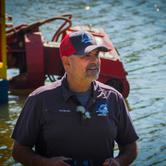How to Clean Murky Pond Water
Have you ever noticed that your pond's water is crystal-clear in the winter and murky pea-green in the summer? This is due to various natural processes that cause water to turn murky or clear. In the summer, frogs, turtles, and even fish are active. They eat food, produce waste, and stir up the nutrients on the bottom of the pond, which can lead to cloudy water or even an algae outbreak. In the winter, fish and reptiles slow their metabolisms and, in some cases, hibernate. While algae do grow in the winter, it does so very slowly due to a lack of nutrients and a much weaker sun than in the summer. You'll notice that your water is super clear in the winter, but it's hard to enjoy when it's cold outside. Fortunately, you don't have to wait until winter to have crystal-clear water for your HOA, golf course, or backyard pond. We want to share five tips on how you can mitigate or even prevent murky pond water from forming in the first place.
Limit Organic Debris
Nuisance algae outbreaks can cause a nice-looking pond to turn into something you'd see in a horror movie in a few days. In addition to sunlight, the algae feed upon the decaying organic nutrients at the bottom of the pond, such as dead fish, leaves, and even pet waste. This is why you should continuously clean up organic debris, such as leaves and tree branches, from the sides of your ponds. Eventually, the wind will pick it up and drop it into your pond, where it will sink to the bottom and become food for nuisance algae. If you have fish in your pond, you can also prevent cloudy water from forming by limiting the amount of food you feed them. You should give them only what they can consume in 60 seconds. Otherwise, the food will find its way to the bottom of the pond and eventually cause an outbreak.
Use an Aerator
Using an aerator can help protect ponds and aquatic animals from a nuisance algae outbreak. It adds oxygen to the water, allowing beneficial bacteria to thrive and break down organic matter. It also helps ventilate excess harmful carbon dioxide from your ponds. Aerators can be added during an algae outbreak to help protect your fish and clear up the pond. Algae consume oxygen alarmingly fast and can choke a pond to death in a few days. A portable aerator can help keep your aquatic animals alive while you deal with the problem.
Chemicals or UV Light
Several chemical products can help prevent or cure an algae outbreak and improve water clarity. However, due to human and animal exposure, many pond managers and homeowners are wary of putting chemicals into their water. Instead, they will add a portable device to the water column that uses ultraviolet rays to kill harmful algae and bacteria. The downside to this method is that it also kills good bacteria. If you rely on water additives, look for an organic, all-natural bacteria solution that adds beneficial bacteria to your pond. It's safe to use and can help improve water clarity and remove harmful algae from the water column.
Dredge Your Pond
The root of all evil in your pond is the organic sediment at the very bottom. There is very little to no oxygen here, which means that organic matter cannot decay. As the warm spring months roll around, all of the organic debris collected over the fall and winter will act as a buffet table and feed nuisance algae outbreaks. Dredging your ponds removes the organic sediment responsible for cloudy water and nuisance algae. As a bonus, you can use the dredged material as organic fertilizer for the garden or lawns.
Nationwide Pond Dredging Services
At American Underwater Services, we specialize in HOA, golf courses, farms, and homeowner pond dredging. We can help you regain control over your ponds and turn them into crystal-clear water havens for fish, animals, and people alike. Call us today at (817) 377-8512 to learn more about our nationwide pond dredging and cleaning services. We can travel anywhere in the continental U.S. to help you with your dredging needs. [author_box]




